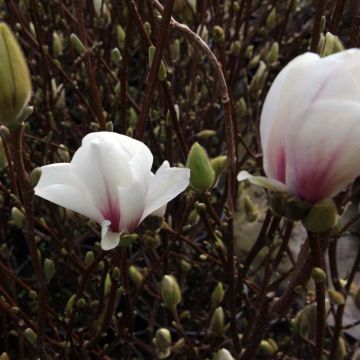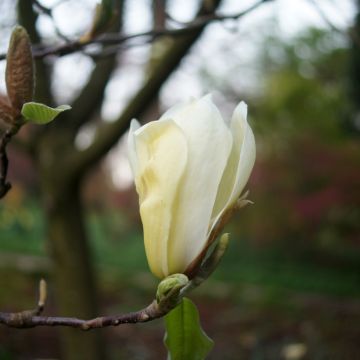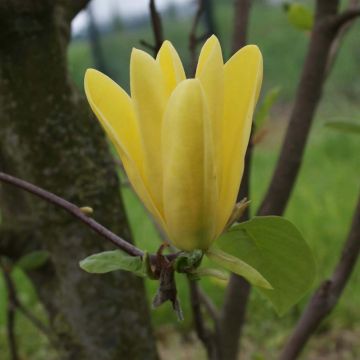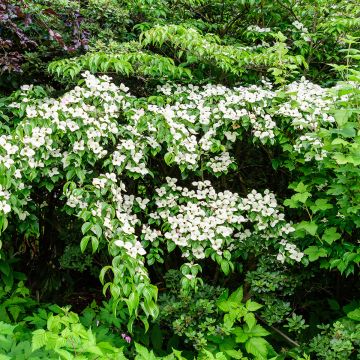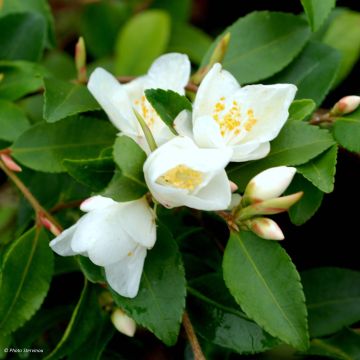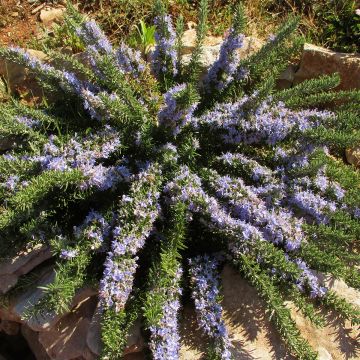

Magnolia x acuminata Blue Opal
Magnolia x acuminata Blue Opal
Magnolia x acuminata Blue Opal ®
Magnolia
Bush having undergone a reshipment (the one from 08/21 not having survived). Beautiful, well-ramified bush. Immediately rehydrated upon arrival and planted in partial shade as our lovely region is experiencing increasingly intense sunlight. Waiting for it to take root and for the next colourful flowering.
Nathalie, 05/06/2023
This item cannot be shipped to the selected country
Delivery charge from €5.90
Delivery to Corse prohibited
More information
Schedule delivery date,
and select date in basket
This plant carries a 24 months recovery warranty
More information
We guarantee the quality of our plants for a full growing cycle, and will replace at our expense any plant that fails to recover under normal climatic and planting conditions.
From €5.90 for pickup delivery and €6.90 for home delivery
Express home delivery from €8.90.
Delivery to Corse prohibited: UE law prohibits the import of this plant from mainland France to Corse as part of the fight against Xylella fastidiosa. Please accept our sincere apologies.
More information

Does this plant fit my garden?
Set up your Plantfit profile →
Description
The Magnolia Blue Opal is the first hybrid with blue flower buds, more precisely a bluish cerulean with a touch of gray. They open to yellow flowers with green reflections, albeit small in size, but offering a unique and refined color palette. Each flower is a beautiful surprise, standing like a small candle on young, tender green foliage. The flowering of this large bush with a broadly conical habit takes place in May-June. While all flowering magnolias are unforgettable, this variety is truly exceptional. Provide it with moist soil without excessive limestone and a sunny to partially shady exposure.
This Blue Flowered Magnolia, belonging to the magnolia family, is a recent American creation resulting from the cross-breeding between the vigorous Magnolia acuminata, a North American tree with yellow flowers, and the M. denudata, a Chinese tree with white flowers. A branched tree with an upright form, taller than it is wide, it reaches a height of about 6 meters (20 feet) at maturity, with a width of 3-4 meters (10-13 feet). Its growth is fairly rapid. Often presenting an open habit, it grows on a single trunk. Its deciduous foliage consists of obovate, dark green leaves, paler on the underside and finely hairy, turning yellow-brown in autumn, measuring 15 to 20 cm (6 to 8 in) in length. In May-June, solitary and erect flowers, measuring 8 to 10 cm (3 to 4in) in height, appear at the end of the branches, after the leaves have emerged. These fragrant flowers are formed by wide blue petals that turn bright yellow with a green wash as the flower opens. These flowers bloom from buds protected by silky bracts. It should be noted that this magnolia is relatively tolerant of limestone in the soil, although not in excess.
This Magnolia Blue Opal is not only an ornamental tree, but also a botanical curiosity that will be a pleasure to introduce to passing friends. It will make an impression in a small-sized garden and catch the attention of curious observers in a large park. It is most often used as a solitary specimen in the middle of a short grass meadow, where its unique spring flowering is most effective. But once the flowering is over, the small tree becomes inconspicuous. To take its place, also consider other small trees such as the Summer Tamarisk, the Wedding Cake Tree, or shrubs like mock oranges, lilacs, beautybush, botanical roses, and many more. The Daphne Magnolia can also be associated with a mass planting of acid-loving shrubs (Rhododendrons, Camellias, Hydrangeas, Pieris, Daphne, Witch-hazels...), for a Japanese-style garden. It is also possible to create beautiful flowering hedges along pathways, alternating this Magnolia with other cultivars (Magnolia grandiflora, stellata, Magnolia denudata...). Its root system is not a danger to foundations, so it can be planted against a house wall.
Anecdote:
Magnolias are ancient trees, with fossils dating back more than 20 million years. Their magnificent flowering is considered one of the most primitive: their flowers are, from an evolutionary point of view, similar to the earliest existing flowers.
The bark of magnolias has medicinal properties and is used in cosmetics.
Their wood is considered precious.
Historical:
It was named Magnolia in 1703 by Charles Plumier, botanist to King Louis XIV, paying homage to the physician-botanist Pierre Magnol (1638-1715), who was one of the directors of the Botanical Garden of Montpellier in the late 17th century. Its specific name, soulangeana, originates from Etienne Soulange-Bodin (1774-1846), a retired cavalry officer from Napoleon's army who dedicated himself to horticulture. In his château de Fromont, near Paris, he became passionate about magnolias and obtained this hybrid in 1829, the origin of a magnificent lineage of cultivars today!
Report an error about the product description
Magnolia x acuminata Blue Opal in pictures


Plant habit
Flowering
Foliage
Botanical data
Magnolia
x acuminata
Blue Opal ®
Magnoliaceae
Magnolia
Cultivar or hybrid
Other Magnolia
Planting and care
The Magnolia 'Blue Opal' prefers sheltered positions, sunny to semi-shaded exposures, a moist, well-drained, rich, even slightly chalky, neutral or acidic soil. It is not fussy about the soil quality. On the other hand, it does not like overly dry soils, windy locations, or root competition, as its root system is shallow. Despite good hardiness, it is preferable to protect young subjects from severe frost in the first years following planting. Note that late frosts and cold winds can damage flower buds and young leaves and thus harm flowering. Planting of the Magnolia can be done in spring or autumn, outside the freezing period, ensuring it is sheltered from cold winds. Dig a hole 80 cm (32in) on each side and equally deep, with a good supply of ericaceous compost. Take care to gently handle it when planting it in the hole, so as not to break the fleshy but fragile roots. Immediate watering, with lime-free water (rainwater), allows the soil to be settled around the roots. During the first year of planting, the Magnolia requires one watering can per week. It will appreciate a good mulch once a year in spring. It is recommended to mulch around its base, to retain moisture during the hot season, enrich the soil, and protect it from the cold in winter. As its roots are fragile, it is best to avoid transplanting it once established. The only enemies of the Magnolia are pests such as scale insects, snails, and slugs that sometimes attack young plants significantly, as well as diseases such as root rot (in overly waterlogged soil), coral disease, and Pestalozzia. Note that magnolias are ornamental trees that tolerate air pollution well.
Planting period
Intended location
Care
-
, onOrder confirmed
Reply from on Promesse de fleurs
Spring-flowering shrubs
Haven't found what you were looking for?
Hardiness is the lowest winter temperature a plant can endure without suffering serious damage or even dying. However, hardiness is affected by location (a sheltered area, such as a patio), protection (winter cover) and soil type (hardiness is improved by well-drained soil).

Photo Sharing Terms & Conditions
In order to encourage gardeners to interact and share their experiences, Promesse de fleurs offers various media enabling content to be uploaded onto its Site - in particular via the ‘Photo sharing’ module.
The User agrees to refrain from:
- Posting any content that is illegal, prejudicial, insulting, racist, inciteful to hatred, revisionist, contrary to public decency, that infringes on privacy or on the privacy rights of third parties, in particular the publicity rights of persons and goods, intellectual property rights, or the right to privacy.
- Submitting content on behalf of a third party;
- Impersonate the identity of a third party and/or publish any personal information about a third party;
In general, the User undertakes to refrain from any unethical behaviour.
All Content (in particular text, comments, files, images, photos, videos, creative works, etc.), which may be subject to property or intellectual property rights, image or other private rights, shall remain the property of the User, subject to the limited rights granted by the terms of the licence granted by Promesse de fleurs as stated below. Users are at liberty to publish or not to publish such Content on the Site, notably via the ‘Photo Sharing’ facility, and accept that this Content shall be made public and freely accessible, notably on the Internet.
Users further acknowledge, undertake to have ,and guarantee that they hold all necessary rights and permissions to publish such material on the Site, in particular with regard to the legislation in force pertaining to any privacy, property, intellectual property, image, or contractual rights, or rights of any other nature. By publishing such Content on the Site, Users acknowledge accepting full liability as publishers of the Content within the meaning of the law, and grant Promesse de fleurs, free of charge, an inclusive, worldwide licence for the said Content for the entire duration of its publication, including all reproduction, representation, up/downloading, displaying, performing, transmission, and storage rights.
Users also grant permission for their name to be linked to the Content and accept that this link may not always be made available.
By engaging in posting material, Users consent to their Content becoming automatically accessible on the Internet, in particular on other sites and/or blogs and/or web pages of the Promesse de fleurs site, including in particular social pages and the Promesse de fleurs catalogue.
Users may secure the removal of entrusted content free of charge by issuing a simple request via our contact form.
The flowering period indicated on our website applies to countries and regions located in USDA zone 8 (France, the United Kingdom, Ireland, the Netherlands, etc.)
It will vary according to where you live:
- In zones 9 to 10 (Italy, Spain, Greece, etc.), flowering will occur about 2 to 4 weeks earlier.
- In zones 6 to 7 (Germany, Poland, Slovenia, and lower mountainous regions), flowering will be delayed by 2 to 3 weeks.
- In zone 5 (Central Europe, Scandinavia), blooming will be delayed by 3 to 5 weeks.
In temperate climates, pruning of spring-flowering shrubs (forsythia, spireas, etc.) should be done just after flowering.
Pruning of summer-flowering shrubs (Indian Lilac, Perovskia, etc.) can be done in winter or spring.
In cold regions as well as with frost-sensitive plants, avoid pruning too early when severe frosts may still occur.
The planting period indicated on our website applies to countries and regions located in USDA zone 8 (France, United Kingdom, Ireland, Netherlands).
It will vary according to where you live:
- In Mediterranean zones (Marseille, Madrid, Milan, etc.), autumn and winter are the best planting periods.
- In continental zones (Strasbourg, Munich, Vienna, etc.), delay planting by 2 to 3 weeks in spring and bring it forward by 2 to 4 weeks in autumn.
- In mountainous regions (the Alps, Pyrenees, Carpathians, etc.), it is best to plant in late spring (May-June) or late summer (August-September).
The harvesting period indicated on our website applies to countries and regions in USDA zone 8 (France, England, Ireland, the Netherlands).
In colder areas (Scandinavia, Poland, Austria...) fruit and vegetable harvests are likely to be delayed by 3-4 weeks.
In warmer areas (Italy, Spain, Greece, etc.), harvesting will probably take place earlier, depending on weather conditions.
The sowing periods indicated on our website apply to countries and regions within USDA Zone 8 (France, UK, Ireland, Netherlands).
In colder areas (Scandinavia, Poland, Austria...), delay any outdoor sowing by 3-4 weeks, or sow under glass.
In warmer climes (Italy, Spain, Greece, etc.), bring outdoor sowing forward by a few weeks.



































